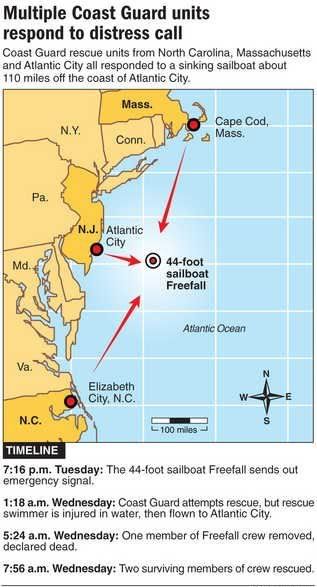
Rescued were Dr. Kevin Hogan, a 52-year-old dentist and Teresa Gravie, 44 co-owner of GLC Construction of Mt Pleasant, SC. Phil Rubright, a 65-year-old Detroit resident was recovered but pronounced deceased by the Atlantic County Medical Examiner Office in Atlantic City.

Dr. Kevin Hogan
The crew of Free Fall had been battling heavy weather and had just gone below because of the worsening weather when a rouge wave rolled the 44 foot sail boat, which after many frightening moments righted itself. During the roll the boat's EPIRB was activated and carbon fiber mast broke off just above the boom. The roll also filled Free Fall with up to six feet of water, shorted out the electrial system which made both radio and bilge pumps inoperatble. The crew would spend the next 12 hours bailing water.
The Coast Guard began its search after watch standers at the Rescue Coordination Center in Portsmouth received the Emergency Position Indicating Radio Beacon (EPIRB)
alert now trasmitting from the severely damaged 44 foot Swan sailboat.
After obtaining the location and confirming the identy of Free Fall as well as location, Coast Guard rescue crews, aboard a C-130J and MH-60 Jayhawk helicopter were launched from Coast Guard Air Station Elizabeth City, N.C.
(Questions remain as to why the Coast Guard didn't launch one of their helicopters from nearby Air Station Atlantic City in the first place. Further why the long delay from the time the EPIRB was active until, Air Station Elizabeth City launched the Jayhawk?)
Sailor Gail Bowdish recounts in her blog Shanti, building wind and seas 24 hours after she departed Mystic, CT. Bowdish was aboard Joy For All, a Farr 50 heading south as well and was approximatly 60 miles north of Free Fall when she first heard the USCG broadcast a PAN PAN PAN alert discribing an EPIRB signal indicating the vessel Free Fall in possiable distress.
At 21:00 on the 28th Sealand Pride was heading north for Europe on her regular bi-weekly run. She reported a position of 34.48N and 71.42W directly south of Free Fall. At the time she reported wind 260 at 52 knots and noted that a pressure reading of a very low 1000 mlb.
Upon hearing the same Pan Pan Pan hear by Gail Bowdish aboard Joy For All Sealand Pride altered course and began making way toward the stricken sailboat. It would take her another 9 hours to arrive on scene.
Around 1 AM, six hours after the rouge wave demasted Free Fall, the Elizabeth City rescue crews arrived on scene but were unable to hoist the three passengers from the FREE FALL due to the extreme weather conditions consisting of rain and 40-50 knot winds and 40-50 foot seas. Additionaly the pitching deck, which was covered with a tangle of rigging wire and lines increased the risk to an extreme level.
The rescue crew determined that in order to conduct a safe hoist the passengers and the rescue swimmer had to enter the water. The rescue swimmer and Mr. Rubright entered the water to attempt the hoist but the rescue basket and hoist cable were damaged by a large wave.
The helicopter crew then deployed a life raft and Mr. Rubright was placed in it. Reportedly another large wave hit and injured the rescue swimmer and tossed Mr. Rubright from the life raft. The injured rescue swimmer was unable to recover Mr. Rubright.
The helicopter crew employed the Emergency Recovery Device (ERD) to recover the rescue swimmer. This manual recovery device is only used during the most extreme circumstances and the person being hoisted must be trained and wear a rescue strap.
Without the means to recover Mr. Rubright, low on fuel after spending nearly 2 hours in the air the helicopter crew called for assistance and departed for Atlantic City to seek treatment for the injured rescue swimmer.
The Coast Guard then launched two MH-65 Dolphin rescue helicopter crews from Air Station Atlantic City along with a HU-25 Falcon jet and a MH-60 Jayhawk helicopter crews from Air Station Cape Cod, Mass. The 270-foot Coast Guard Cutters Northland and Seneca, along with the 87-foot Coast Guard Cutter Mako were also dispatched to the scene.
At 06:00 on the 29th Sealand Pride reported the wind at 270 at 42 knots, but she was still 39 miles to the south of Free Fall but was making nearly 10 knots where she was only able to make and average of 5.3 knots in the heavy seas that held during the previous 9 hours.
Once on scene at 39.06N – 71.42W she was reported winds that had eased to 27 knots. Two hours later having drifted along with S/V Free Fall she reported a position of 39.06N – 71.36 33 knot winds out of 280 and resumed her voyage.
The Atlantic City helicopter crews were able to relocate the stricken vessels crew and relay the position to the incoming Cape Cod rescue crews.
Upon arriving on scene the Cape Cod helicopter crew recovered Mr. Rubright at around 5AM from the water and flew him to Atlantic City where he was pronounced dead by the Atlantic County Medical Examiner.
A second MH-60 Jayhawk rescue helicopter USCG 6041 from Elizabeth City was dispatched to the scene and hoisted Hogan and Gravie. Rescue operation was completed at 8:15 AM, and Hogan and Gravie were flown to Air Station Atlantic City where they were turned over to local EMS crews and taken to a AtlatiCare Regional Medical Center in Atlantic City for treatment.
Below is video off the second rescue attempt shot from a USCG Doplin helicopter at 1000 AGL. The first part of the video is shot using nightvision and the second part in normal vision.
USGC Video of the second rescue attempt
Both Hogan and Gravie suffered from mild hypothermia, cuts, brusies and in the case of Gravie a possiable concusion but and are reported in good condition.
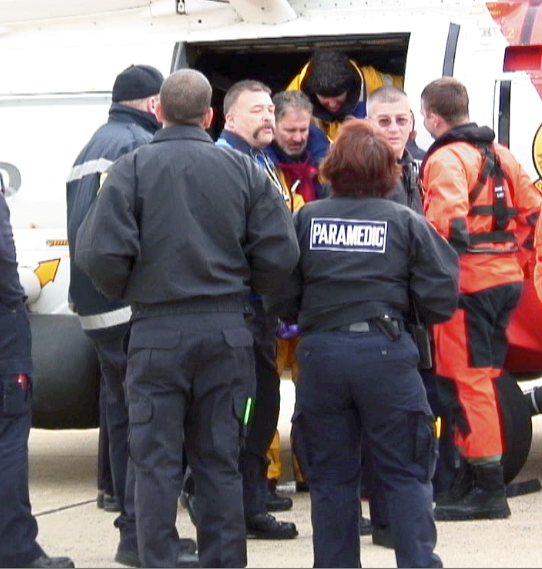
Hogan (standing) waits for paramedics to transport him to a waiting ambulance.
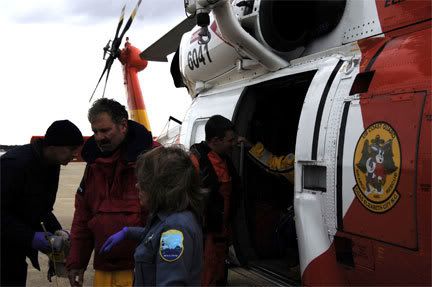
Emergency personnel transfer Kevin Hogan, 52, to an awaiting ambulance USCG Photo
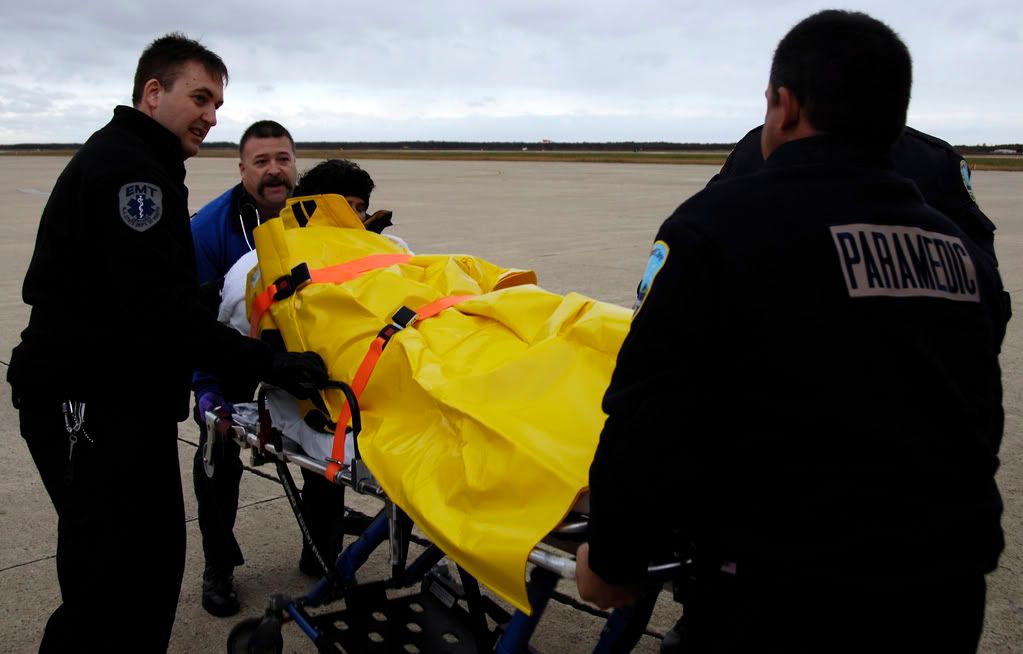
Teresa Gravie, 44, is transported to a waiting ambulance USCG Photo
USCG Video of the USCG Jayhawk helicopter 6041 landing at Air Station Atlantic City
In addition to the rescue of the sailing vessel Freefall, the Coast Guard is reporting the rescue and assistance of 4 other vessels and and 7 sailors during the October 27 - 29 2008 storms off the east coast.
The death of Mr. Rubright, is tragic and no doubt the USCG will conduct an in depth investigation regarding the chain of events that happened aboard S/V Freefall and during the first rescue attempt.
It's not like the coasties to tell someone to enter the water and then leave the scene. I'm sure the rescue swimmer took one heck of a beating and was severely injured or he would not have left the water without Mr. Rubright.-LFB
Photos of S/V Free Fall a 44 foot Swan US-777 from YachtWorld.com prior to her being sold, the listing has since be removed.
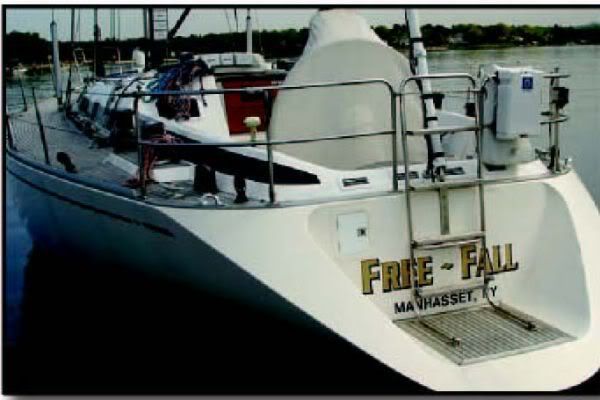
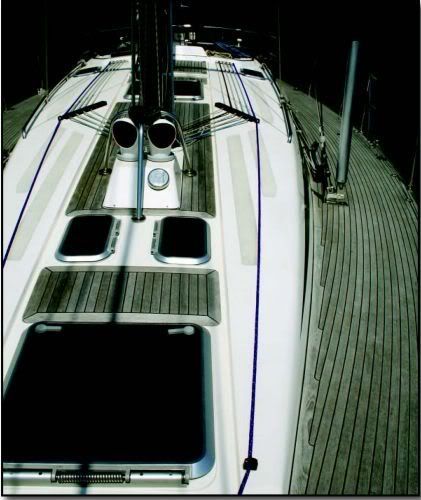
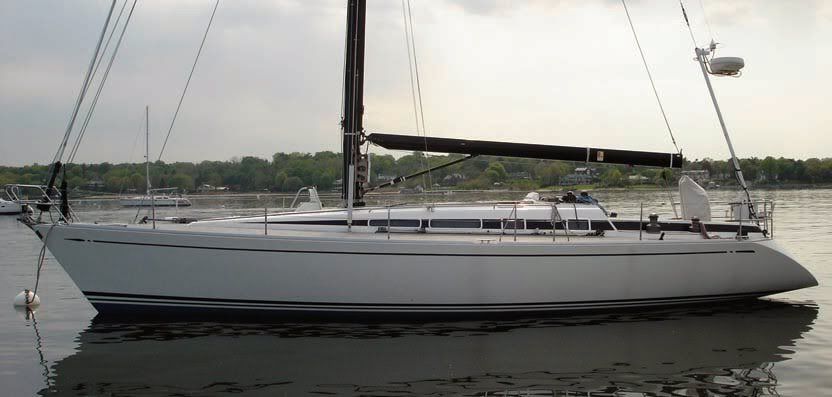
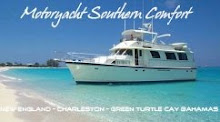

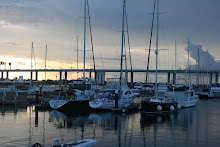

My favorite Uncle... master story teller, and the best Sailor on the Great Lakes.
ReplyDeletePhil Rubright was a former neighbor from Berkley, MI and a heck of a sailor. He was VERY experienced: sailing in many single-handed races and had several trans-Atlantic crossings. We will miss Phil on the Great Lakes.
ReplyDeleteSad, --RML--
Jeffrey,
ReplyDeleteI don't doubt that at all. I'm sure he was all that and much more.
LFB
Coast Guard screwed the guy told him to get in the water and then let him drown. Someone needs to be the goat! Bet heads roll over this one. Tragic!
ReplyDeleteThis comment has been removed by a blog administrator.
ReplyDeleteThe trouble with anonymous comments is that when people get a little too excited, the first thing they do is start name calling.
ReplyDeleteTo the poster who's comment has been removed, I think you make a valid point, several points in fact.
".....the rescue swimmer who entered the water in those conditions, and the rest (of the) SAR team that went out there to get FREE FALL, acted flawlessly."
I'm sure they did everything they could given the sea state and weather at the time.
"If the crew (of Free Fall) had watched the weather more closely, like most of the other boats out there did prior to the incoming weather this might have been avoided."
The high seas weather forecast called for deteriorating conditions but not until well after the 29th. In fact 2 other vessels and 7 people had to be rescued during the October 28-29 storm. 6 other boats were damaged before they could make port safely.
"I hope you never have to make the choice the rescue swimmer or the Helo Cmdr had to make that day."
I doubt there is anyone reading this who would ever want to be in a position of making the call to leave someone in the water, and break off a rescue attempt. But that is why the USCG has a Helo Commander, and they are trained that, this is what we do when things go really bad, we protect our crew.
Easy to say from a nice dry chair, isn't anonymous. (Nov 6 7:59)If you actually read the stories, you would have realized that they had no choice. There was no way to attach Mr. Rubright to the Emergency Recovery Device hook, nor anyway to get him back to the boat. Have you ever been over 100 miles out to sea, hovering above 40-50 foot waves with nobody to help you if you go down? I didn't think so.
ReplyDeleteI am sorry about the name. I should have thought a little harder about it before I made that statement. I would have left my name and rank but it would not allow me too. Thanks for at least talking about it. It just makes me angry when people comment on something they know nothing about
ReplyDeleteAs an offshore skipper traversing the waters from Cape Cod to the Caribbean fairly regularly, weather is always the prime consideration.
ReplyDeleteDue to hurricane season extending into November and insurance carriers not allowing vessels to be south of a certain latitude prior to November 1st, there is always the risk of encountering gale or storm force conditions. The objective is to make prudent decisions pertaining to offshore weather; however, during this time of year it is sometimes difficult to avoid gale force conditions once you’re well offshore.
When things begin to turn bad mid-ocean, unfortunately, the circumstances can and do become extreme. It's something that may be hard to understand for those who have never been in extreme gale force conditions.
This is a very sad and tragic loss and I'm sure in those most difficult conditions, the SAR crew did everything they possibly could to preserve life.
Sincere condolences to the family of Mr. Rubright.
EJS
Any update from the CG investigation. It would be very educational to know what happened to a Swan 44 the Rolls Royce of sailboats. Storm in the Gulf Stream is severe but what lessons learned, what happened to the bot, if it sank why?
ReplyDeleteArthur
Hi we were in the same storm for 39 hours about 300 miles offshore and Just North of the Gulf Stream. Our Amel sailboat hung in there and we saw waves way over 50 feet and winds close to and possibly over 80 knots. It was harrowing as we were being blown into the Gulf Stream 60 miles away. Even though we had deployed the Jordan Series drogue (probably saved our lives) we were moving at 3 1/2 knots towards a northern flowing eddy in the stream.
ReplyDeleteHerb the weatherman even came on for 3 days at 9am to see if we were still afloat. we heard the search planes on channel 16 asking to keep an eye out for men in the water Fortunately for us the wind was so strong it blew the eddy 60 miles further east and gave us a reprieve.
the wind finally abated to 50 knots and we sailed south to cross the eastern flowing stream. Thank you to my crew, Amel, and Mr Jordan.
Eric freedman
S/v Kimberlite
Amel #376.
Kimberlite@optonline.net
Thank You and I have a nifty offer: How To Budget House Renovation cost to gut and renovate a house
ReplyDelete